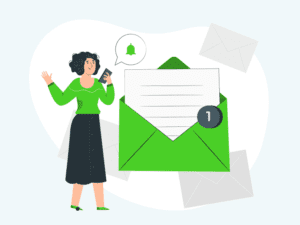Marketing professionals have a lot on their plate. Between cross-departmental coordination, managing campaigns, updating the website, and the millions of tasks in between, there never seems to be enough time.
Out of everything they have to do, one of the most time-consuming tasks for marketers is creating and sustaining email marketing campaigns.
The reason for this is not surprising. It’s because email marketing works and it’s worth spending time on them. The fact is that, when done correctly, these campaigns are fantastic tools to boost sales, grow leads and drive engagement.
Why email marketing is so popular

According to Statista, there will be 4.48 billion users by 2024. That means that no matter what niche a company is in, your market is going to be reachable by email. Then add to that the fact that email marketing has the highest return of investment for small businesses and 80% of marketers reported an increase in email engagement from 2019 to 2020.
In the end, you’re left with all the key ingredients for high-return marketing efforts. If you’re able to create the right recipe.
Types of emails
There are quite a few ways emails are used for marketing. Here are a few common examples.
Welcome emails
These simply thank the new sign up for joining the mailing list and are usually sent out right after. The idea here will be to convert new customers.
Newsletters
Regular updates about your company, products, services, or anything else your target might find of value.
Milestones
Big change taken place? These emails inform your contacts about what’s going on in your brand.
Free gift emails
These offer your recipients a nice freebie, whether an ebook, video, podcast episode or similar content.
Promotional marketing
Whether to offer discounts or simply let customers know about new products, these are the more on-the-nose type emails. They can also be combined with other emails, such as milestones that also offer a discount.
Abandoned cart
The classic nurture email, these are for ecommerce websites where a customer has put something in their cart and then left it there. The idea is to remind them a day or so afterwards so they complete their purchase.
Simple value
Finally, you have emails that have no other on-the-surface purpose than to provide value. There is no call to action or other promotional element—you just want to build the relationship by giving free advice that the recipient actually wants.
Campaigns are generally built up with a combination of different types of emails, depending on the specific purpose you have.
How to simplify your email marketing campaign

In the end, the trick to simplifying your email marketing campaigns is simply a matter of planning and using the appropriate software. It’s always going to take a certain amount of time investment up front but if you plan it properly and automate your entire campaign, you will end up with a highly tailored lead generation or conversion machine that works for you 24/7.
Here’s how you do that.
1. Decide what campaign you want to run
Many of the types of emails outlined above assume you are nurturing existing customers. Others require capturing new leads entirely.
Depending on the email marketing campaign, you may need to first develop a lead magnet, and providing content that your target actually wants to swap their information for is never easy. Then, again depending on the campaign, there are the different landing pages and pop-ups that may need to be created.
And we haven’t even got to the emails yet.
Each email marketing campaign can have up to 10 or 12 emails as a maximum (if properly spread out) and all these emails need to be written. The specific campaign that you want to run will determine the amount of content you need to create. Before you do anything else, you should be clear what you want from the campaign and the resources you need to succeed.
2. Lead generation (optional)
If you’re launching a nurturing campaign or similar for current customers, you’ll already have all the contact details you need. But let’s say you’re interested in trying to convert new customers through inbound or outbound lead generation.
To do this, you’ll need a CRM or sales automation platform that provides all the tools you need. Alternatively, you can invest in all the specific tools individually, but that quickly gets out of control cost-wise.
With a powerful enough platform, for outbound campaigns, you can talk to people on any channel from one place, whether email, LinkedIn, Facebook, Messenger or anywhere else. Having everything in one place means you don’t need to waste time signing into different websites.
If you’re more interested in leveraging the power of content marketing for your lead generation, a good platform should have drag-and-drop builders that allow you to build pop-ups, landing pages, surveys. Anything you need to kick-start the funnel can be quickly and easily created. This should include the actual emails as templates can be created, saved, and reused for more campaigns down the line.

3. Segment your audience
With all the different lead generation efforts you have going on, your audience is bound to be made up of leads from vastly different backgrounds and demographics. It is highly unlikely (read: impossible) that your email campaigns will be relevant to all of them. This is just as true for your current customers and is why it’s essential that you segment your audience.
If you send out an email campaign about a product upsell, it’s only going to be of interest to individuals who have already purchased the original product. Likewise, if you are launching a campaign to educate potential customers about your product, it’s entirely useless and likely annoying if they’re already customers. Abandoned cart campaigns only make sense if you’ve put something in your cart. Free gifts can fall flat if sent to the wrong person. You get the idea.
In fact, segmentation can result in up to 760% increase in revenue. Assuming this is your first campaign, it’s a good practice to keep it general at first and then segment further as you create more focused campaigns.
Some good ways to segment it is by lead generation or sales conversion, or specific product or service. There’s no right or wrong way to segment your audience; it all depends on what your particular needs are.
4. Personalize your campaign
If you’ve taken the time to segment your audience, all that hard work will be for nothing unless you personalize it.
Personalized messaging is the number one tactic used by marketers to improve their response rate. Every campaign you launch should be personalized as much as possible. Many aspects of personalization can be taken care of by using automation software, such as adding in their name or sending offers on their birthday.
It may take more time to personalize the messaging up front, but having highly specific messages for your different target audiences really does pay off in the long run. Besides, once it’s done, you can save and automate everything from then on out.
5. Provide a clear call-to-action (CTA)
This gets a point on its own because of how important it is. If you do absolutely everything right but don’t include a clear, simple CTA, then all your efforts will be for nothing.
The call-to-action is simply the desired action you’d like the recipient to take. It can be “Learn more!” “Contact us” or “Buy now.” Sometimes you’ll see it in the form of a sentence (look at the last sentence of this blog post for an example).
Either way, every campaign has a goal and the goal requires the recipient to take a specific action. Make it as easy as possible for them to do so!
6. Test and track
The best feeling as a marketer is seeing your campaign go live and get results. But before you set everything up, it’s a good idea to test how you’re doing. According to Litmus, A/B testing can result in a 37% increase in ROI and is definitely something that all marketers should be doing. That said, it does involve proper analytics capabilities and actionable reports.
Sales and marketing CRM platforms allow you to test your newly created campaigns to see if there are any glitches or not.
Then, when it is actually time to go live, you can track everything. How many clicks? How many downloads? How many conversions? All the information you need is there at your fingertips, including A/B testing capabilities and insights for any retargeting campaigns.
Beyond the email marketing campaign
A good CRM will undoubtedly help you with your email marketing efforts, but that’s only the beginning of what it’s capable of. It’s a whole platform that automates, records, and encourages communication across the entire platform.
If you’d like to find out more about how a sales and marketing CRM can empower your team to reach the next level of success, please feel free to reach out to us at Pipeline.so.

